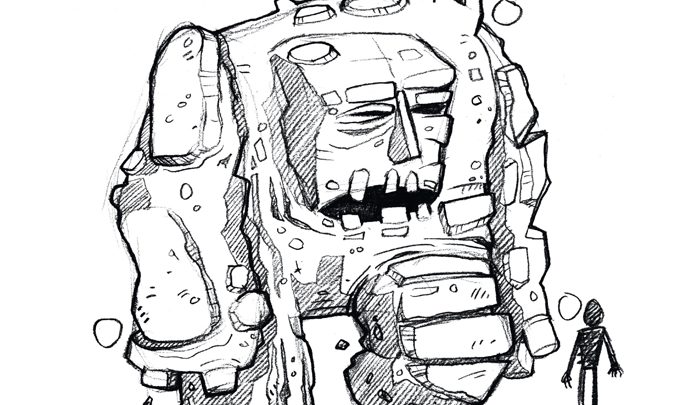Why We Should Give Children Frightening Books

Our instinct as adults is to protect children from the scary stuff – but should we reconsider, asks Curtis Jobling…

I blame my imagination. That was the principal reason I was such a colossal scaredy-cat as a child. It didn’t matter what I heard, or saw, or read, my unconscious had an uncanny way of intensifying anything remotely frightful.
If I saw tree-branch shadows playing across my window at night, they were always giant skeletal fingers. If I heard something moving through the undergrowth at dusk, you could bet your bottom dollar it was a werewolf stalking me.
And don’t get me started on the things that lurked in the graveyard around the corner from the house I grew up in.
Fear is the emotion that gets all the bad press. Sure, you can have fiery, furious Anger, gleeful, happy-clappy Joy, weeping and wailing Sadness and disapproving Disgust, but for some reason Fear is the one that folk don’t want to talk about, certainly not with their children.
Some parents would rather pretend it wasn’t there, cover their kids in bubble wrap and keep that particular beast from the door. This is folly, and I’m going to try and explain why.
Childhood can be scary. Not in a monstrous sense, but certainly as a world into which children are taking tentative steps; it can be intimidating, and frightening.
For some young people, the real world can be a place where there are genuine scares to contend with, and bad things happen. Where better to escape this misery – any misery – than within the pages of a good book? A well-crafted, age-appropriate scary story will always do more good than harm.
The importance of nightmares
Show me someone who doesn’t know what fear is and I’ll show you a troubled individual. It’s an emotion that starts the blood pumping, gets the heart racing, reminds us that we’re alive.
My earliest recollection of fear is via the nightmares of my childhood. Note to parents: you can’t protect your children from nightmares. We all suffer from them, big and small. They’re how our subconscious minds deal with real-life troubles, many of which we may not even be aware of.
They can of course be influenced by things to which we are exposed; in my case, it was the stories I read, and tales I was told. Where The Wild Things Are and Tchaikovsky’s Nutcracker Suite are entirely responsible for the fact that I slept surrounded by cuddly toys and action figures for a fair few of my formative years.
Hiding under the sheets can only last so long, though. Facing one’s fears for the first time is a rite of passage. Only by being bold and conquering the things that scare us, will we become more confident, well-rounded individuals.
Cinema has a lot to answer for. Some of my earliest memories of frights were via the films I watched with my dad, curled up on the sofa beside him, taking in the late night chiller.
Invariably this was an old black-and-white “Creature Feature”, showcasing the shambling and slashing talents of Universal Studios’ movie monsters.
Lon Chaney Jr’s Wolfman really stayed with me; I couldn’t pass a fog bank without imagining the furry fiend was hot on my tail.
Those scares I suffered were visceral, memorable, resulting in my overactive imagination keeping me awake at night.
Watching scary movies? Fun at the time for sure, but those frights can leave a mark, especially in the case of a young viewer. Books, however, don’t have the same nightmarish effect on their readers as films do.
Warnings and exploration
When we think of traditional children’s stories, Grimm’s fairy tales often come to mind. These narratives, and others of that ilk, weren’t written to delight and captivate children, but to scare them.
They were cautionary tales, highlighting the dangers of disappearing into the woods, the risk of talking to strangers, and the perils and pitfalls of entering gingerbread houses, or any abode fashioned primarily of cake, candy or confectionary.
Stay away from the dark places, for horror and hellish shenanigans await thee within.
The best way for children to experience fear is from the safety of a good book. A book doesn’t leap out and make you jump. A book doesn’t chase you or beat you.
Tasting terror from within the confines of a book provides the reader with a vicarious thrill, one which they’re in complete control of.
If a story proves scary – shut the book. And if it’s really scary, throw the book in the chest freezer in the garage!
Horror, like any genre fiction, can get a child reading; and the adrenaline-fuelled kick that a fright brings with it can fire a lifelong love of literature.
What’s more, we can work through our fears, both fictional and real, through our love of reading. A shared love of a scary tale could be the springboard for the most skittish soul to overcome that fear.
Shared triumphs
My Max Helsing books feature the exploits of a boy born into a world of monsters, where horrors await him at every turn. Only our hero isn’t frightened by them for the most part. He’s been around them all of his life. Max gets them –it’s humans he doesn’t understand!
But for Max’s friends – gearhead Syd Perez and homeschooled Wing Liu – these terrors are new and, understandably, scare the pants off them.
Syd and Wing have to conquer their fears in each of these stories, battling the things they’re afraid of and coming out the other side stronger and happier.
As an author, fear in a story brings my readers closer to my heroes: they empathise with them, they feel the same sense of panic, of dread. When Max and his friends defeat their demons, that’s a moment of triumph for the reader too.
In closing, I should probably add: I still get nightmares to this day. Only now they don’t really scare me. They’re like private viewings of an original horror movie, meant only for my giddy eyes.
I get a thrill from them. That’s because I know they’re not real. I know I’m going to wake up. Like a scary book, the fright is fleeting – but the enjoyment remains.
Curtis Jobling is an illustrator, animator and author of numerous children’s books – to find out about school visits, see curtisjobling.com.












